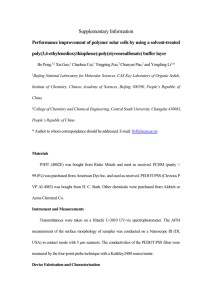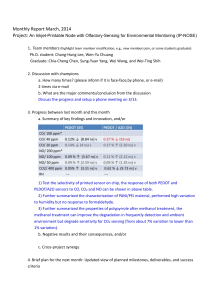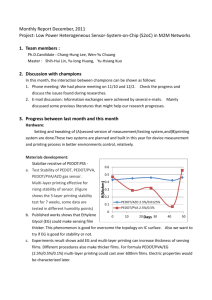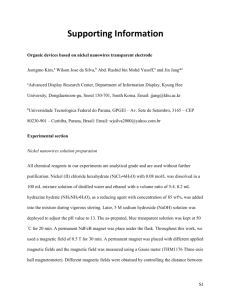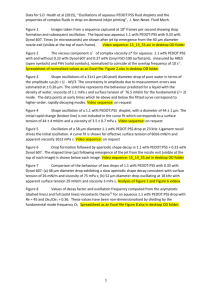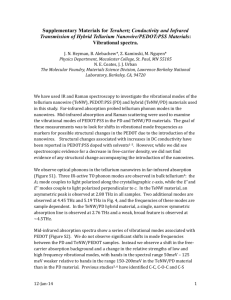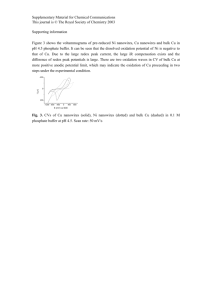ENRICHED POLY(3,4-ETHYLENEDIOXYTHIOPHENE) NANOWIRES WITH MNO NANOPARTICLES FOR ENHANCED ELECTROCHEMICAL ENERGY
advertisement
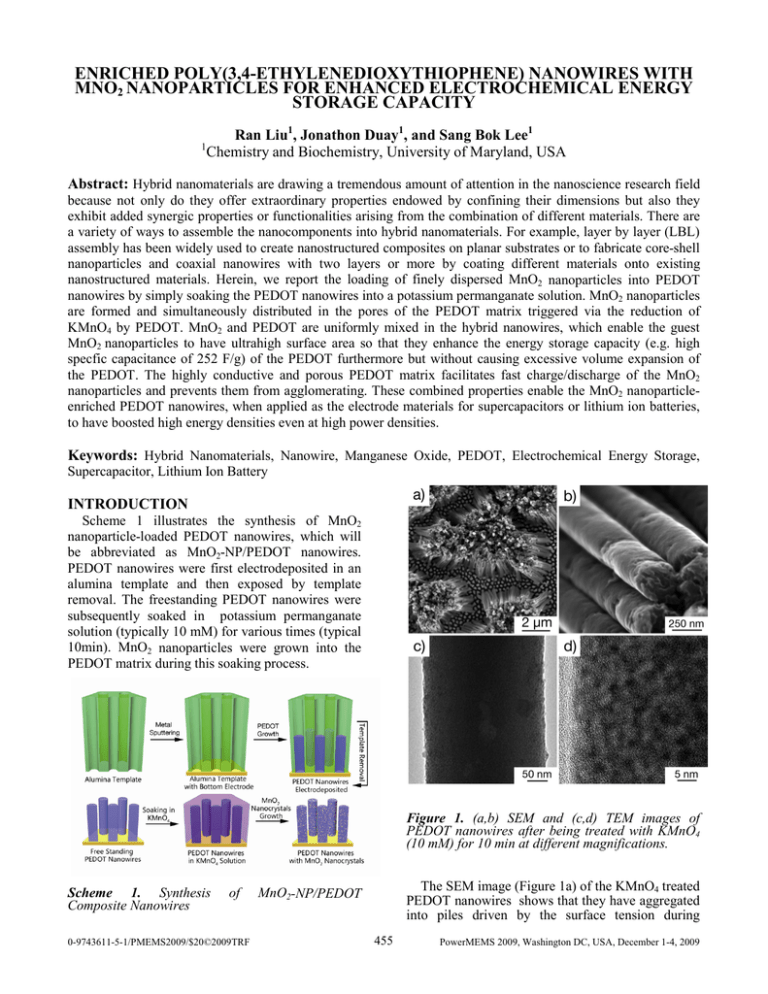
ENRICHED POLY(3,4-ETHYLENEDIOXYTHIOPHENE) NANOWIRES WITH MNO2 NANOPARTICLES FOR ENHANCED ELECTROCHEMICAL ENERGY STORAGE CAPACITY 1 Ran Liu1, Jonathon Duay1, and Sang Bok Lee1 Chemistry and Biochemistry, University of Maryland, USA Abstract: Hybrid nanomaterials are drawing a tremendous amount of attention in the nanoscience research field because not only do they offer extraordinary properties endowed by confining their dimensions but also they exhibit added synergic properties or functionalities arising from the combination of different materials. There are a variety of ways to assemble the nanocomponents into hybrid nanomaterials. For example, layer by layer (LBL) assembly has been widely used to create nanostructured composites on planar substrates or to fabricate core-shell nanoparticles and coaxial nanowires with two layers or more by coating different materials onto existing nanostructured materials. Herein, we report the loading of finely dispersed MnO2 nanoparticles into PEDOT nanowires by simply soaking the PEDOT nanowires into a potassium permanganate solution. MnO2 nanoparticles are formed and simultaneously distributed in the pores of the PEDOT matrix triggered via the reduction of KMnO4 by PEDOT. MnO2 and PEDOT are uniformly mixed in the hybrid nanowires, which enable the guest MnO2 nanoparticles to have ultrahigh surface area so that they enhance the energy storage capacity (e.g. high specfic capacitance of 252 F/g) of the PEDOT furthermore but without causing excessive volume expansion of the PEDOT. The highly conductive and porous PEDOT matrix facilitates fast charge/discharge of the MnO2 nanoparticles and prevents them from agglomerating. These combined properties enable the MnO2 nanoparticleenriched PEDOT nanowires, when applied as the electrode materials for supercapacitors or lithium ion batteries, to have boosted high energy densities even at high power densities. Keywords: Hybrid Nanomaterials, Nanowire, Manganese Oxide, PEDOT, Electrochemical Energy Storage, Supercapacitor, Lithium Ion Battery INTRODUCTION Scheme 1 illustrates the synthesis of MnO2 nanoparticle-loaded PEDOT nanowires, which will be abbreviated as MnO2-NP/PEDOT nanowires. PEDOT nanowires were first electrodeposited in an alumina template and then exposed by template removal. The freestanding PEDOT nanowires were subsequently soaked in potassium permanganate solution (typically 10 mM) for various times (typical 10min). MnO2 nanoparticles were grown into the PEDOT matrix during this soaking process. Figure 1. (a,b) SEM and (c,d) TEM images of PEDOT nanowires after being treated with KMnO4 (10 mM) for 10 min at different magnifications. Scheme 1. Synthesis Composite Nanowires of 0-9743611-5-1/PMEMS2009/$20©2009TRF The SEM image (Figure 1a) of the KMnO4 treated PEDOT nanowires shows that they have aggregated into piles driven by the surface tension during MnO2-NP/PEDOT 455 PowerMEMS 2009, Washington DC, USA, December 1-4, 2009 Mn 2p3/2, Mn 2p1/2 which are centered at 642 and 653.8 eV, respectively, are in good agreement with reported data of Mn 2p3/2 and Mn 2p1/2 in MnO2.[1] solvent evaporation. Figure 1b shows the high resolution SEM image of the same nanowires, which reveals their cigar shapes and rough surfaces. Figure 1c is the TEM image from a segment of KMnO4 treated PEDOT nanowire. Some dark nanoparticles can be vaguely seen, which can be further observed more clearly using a higher resolution TEM image (Figure 1d.) XRD studies shows that these nanoparticles are X-ray amorphours, however, under TEM, they show some weak crystalline structures, which may be introduced by the annealing caused by the heating TEM electron beams. Alternative methods are used to analyse these KMnO4 treated nanowire in order to confirm the existance of MnO2. Figure 2 a-d show the TEM images, Mn K map, S K map, and their mixed map on a segment of MnO2NP/PEDOT nanowire. Figure 2e showed the EDS spectra from a single MnO2-NP PEDOT nanowire. Quantitative information show that the atomic ratio of Mn to S is 1.42:1, which suggests that a large amount of MnO2-NP have been loaded into the PEDOT matrix. THEORY Based on the Mn/S ratio shown in Figure 2e, we can assume that 1 mole of PEDOT can encapsulate c.a. 1.4 moles of MnO2-NP. This process requires 4.2 moles of electrons to reduce the 1.4 moles of KMnO4. However, it is difficult to conceive that 1 mole of PEDOT can provide 4.2 moles of electrons because the PEDOT is the already oxidized form of EDOT. The maximum electrons it can provide are based on its doping level, which is 0.3.[2] This suggests one mole of PEDOT can only provide 0.3 moles of delocalized electrons during the doping (oxidation) process, which is not enough to reduce 1.4 moles of KMnO4. After the MnO2-NPs are loaded in the PEDOT matrix, dilute sulfuric acid is applied to the hybrid nanowires to strip off the MnO2. Electrochemical tests were performed on these MnO2-striped PEDOT nanowires and they showed that the electrochemical properties were retained when compared to the electrochemical properties of PEDOT nanowires before MnO2-NP insertion. Figure 2. (a) TEM image and EDS mapping of (b) Mn, (c) (S), and (d) mixture of Mn and S on a segment of MnO2-NP/PEDOT nanowires Figure 4. (a) IR spectra of PEDOT nanowire (blue) and PEDOT nanowires treated with 10 mM (orange), 20 mM (green) and 50 mM (red) KMnO 4 for 10 min. An absorbance peak at 1044 cm-1 graduately appears as the concentration of KMnO4 increases and can be identified clearly when the KMnO4 concentration has reached 50 mM. (b) XPS spectra of PEDOT before (blue) and after treatment with KMnO4 (orange). Also a small new peak at higher binding energy of 168 eV has appeared. Figure 3. XPS spectra for manganese in the KMnO4 treated PEDOT nanowires Figure 3 show the XPS spectra obtained from the MnO2-NP loaded PEDOT nanowires, the peaks of 456 In order to study the electrochemical energy storage benefits of loading MnO2 into the PEDOT matrix , cyclic voltammetry (CV) (Figure 6a) and galvanostatic charge/discharge (Figure 6b) tests were performed on the PEDOT nanowires before and after KMnO4 treament. The calculated specfic capacitance MnO2-NP/PEDOT nanowires is 250 F/g, which is higher than our previous reported MnO2/PEDOT coaxial nanowires.[7] Due to the large specific surface area of MnO2 NP, the pristine specific capacitance of MnO2 NP can be calculated as 410 F/g, which is higher than other synthesized nanostructured MnO2 supercapacitor electrodes[911] at the same charge/discharge rate. Figure 6b also demonstrates that the MnO2-NP/PEDOT can serve as promising electrode materials for lithium ion batteries. Indeed, nanostructured MnO2 or PEDOT have been respectively reported for applications in lithium ion batteries.[12, 13] Figure 4a show the IR spectra of PEDOT nanowires treated with different concentration of KMnO4 for 10 min. The arising peak at 1044 cm-1 can be assigned to the sulphoxide (S=O bond) stretching mode,[3] which suggests possible oxidation of the thiophene sulphur into sulphoxide by KMnO4. The new peak (168 eV) in XPS analysis (Figure 4b) alludes to the possible oxidation of thiophene sulphur into the sulphone O=S=O group.[4] Similar oxidation on the sulphur sites of PEDOT:PSS by hydrogen peroxide[5] or NaOCl[6] and have been described elsewhere. Scheme 2. Reduction of KMnO4 by PEDOT to form MnO2 By controlling the soaking time and the concentration of the KMnO4, we can regulate the loading amount of MnO2. Figure 5a shows the Mn/S ratio determined by EDS analysis after the PEDOT nanowires reacted with different concentrations of KMnO4 for 1 min. It is worth of noting that the MnO2 loading increases more rapidly at higher concentration of KMnO4, which could be caused by the complete etching away of PEDOT after it is overoxidized into soluble product.[5, 6] Figure 5b shows how the Mn/S ratio responds to the soaking time more linearly. Figure 6. (a) Cyclic Voltamograms of PEDOT nanowires before (blue) and after (orange)10 mM KMnO4 treatment (10 min) scanned at 100 mV/s between 0-1 V in 1 M LiClO4 in water. It is worth noting that although the inclusion of MnO2 NP significantly increases the charge capacity of PEDOT nanowires, the volume of the PEDOT is not expanded significantly. Assuming the diameter of the bottom gold is not affected by the KMnO4, and the PEDOT nanowire swelling is isotropic, the volume expansion rate can calculated as: V2 − V1 d MnO2 / PEDOT / d Au − MnO2 / PEDOT = − 1 Figure 5. MnO2 loading capacity (Mn/S ratio) (1) V d PEDOT / d Au − PEDOT versus (a) different concentrations of KMnO4 for 1 1 min and (b) different soaking times in 10 mM KMnO4. 3 Thus calculated volume expansion rate is 25%. Compared to our previous report,[7] the 457 incorporated MnO2 utilizes less space while providing more energy capacity, which further increases the energy density and power density per volume. Volume expansion of PEDOT nanowire can also be theoretically estimated by the following equation: (2) [4] [5] V2 − V1 n2 d1M 2 = V1 n1 d 2 M 1 Where n2/n1 is the mole ratio of the MnO2 to PEDOT (here-in 1.42), d2, d1 are the density of MnO2 and PEDOT,[14] M2 and M1 is the molecular weights of MnO2 and PEDOT. Based on equation (2) the volume expansion is estimated as 28%, which well matches the experimental obtained volume expansion rate. [6] [7] CONCLUSION In summary, we described the fabrication of MnO2 nanoparticle-loaded PEDOT nanowires by simply soaking the PEDOT nanowires in KMnO4 solution. The formation of MnO2 nanoparticles is triggered via the KMnO4 reduction by the sulfur sites on thiophene rings. The MnO2 nanoparticles boost the energy storage capacity by 4 times while only causing the PEDOT volume to expand 25%. The hosting material, highly conductive and porous PEDOT, facilitates the fast charge/discharge rate of the MnO2 nanoparticles and prevents them from aggregation. These synergic properties enable the MnO2-NP enriched PEDOT nanowires to be promising electrode materials with high energy densities and high power densities for supercapacitors and lithium ion batteries, which pave the way for the investigation of other types of hybrid nanomaterials for applications in electrochemical energy storage. [8] [9] [10] [11] REFERENCES [1] [2] [3] Reddy, A.L.M., et al., Coaxial MnO2/Carbon Nanotube Array Electrodes for High-Performance Lithium Batteries. Nano Letters, 2009. 9(3): p. 1002-1006. Randriamahazaka, H., V. Noel, and C. Chevrot, Nucleation and growth of poly(3,4-ethylenedioxythiophene) in acetonitrile on platinum under potentiostatic conditions (vol 472, pg 103, 1999). Journal of Electroanalytical Chemistry, 1999. 476(2): p. 183-183. Fawcett, W.R. and A.A. Kloss, Solventinduced frequency shifts in the infrared spectrum of dimethyl sulfoxide in organic solvents. Journal of Physical Chemistry, 1996. 100(6): p. 2019-2024. [12] [13] [14] 458 Gardella, J.A., S.A. Ferguson, and R.L. Chin, π*-π Shakeup Satellites for the Analysis of Structure and Bonding in Aromatic Polymers by X-Ray Photoelectron-Spectroscopy. Applied Spectroscopy, 1986. 40(2): p. 224-232. Yoshioka, Y., P.D. Calvert, and G.E. Jabbour, Simple modification of sheet resistivity of conducting polymeric anodes via combinatorial ink-jet printing techniques. Macromolecular Rapid Communications, 2005. 26(4): p. 238-246. Yoshioka, Y. and G.E. Jabbour, Inkjet printing of oxidants for patterning of nanometer-thick conducting polymer electrodes. Advanced Materials, 2006. 18(10): p. 1307-1312. Liu, R. and S.B. Lee, MnO2/Poly(3,4ethylenedioxythiophene) coaxial nanowires by one-step coelectrodeposition for electrochemical energy storage. Journal of the American Chemical Society, 2008. 130(10): p. 2942-2943. Liu, R., S.I. Cho, and S.B. Lee, Poly( 3,4ethylenedioxythiophene) nanotubes as electrode materials for a high-powered supercapacitor. Nanotechnology, 2008. 19(21): p. 215710. Wang, X.Y., et al., Sol-gel template synthesis of highly ordered MnO2 nanowire arrays. Journal of Power Sources, 2005. 140(1): p. 211-215. Shinomiya, T., V. Gupta, and N. Miura, Effects of electrochemical-deposition method and microstructure on the capacitive characteristics of nano-sized manganese oxide. Electrochimica Acta, 2005. 51(21): p. 4412-4419. Ragupathy, P., H.N. Vasan, and N. Munichandraiah, Synthesis and characterization of nano-MnO2 for electrochemical supercapacitor studies. Journal of the Electrochemical Society, 2008. 155(1): p. A34-A40. Liu, D.W., et al., Hydrous manganese dioxide nanowall arrays growth and their Li+ ions intercalation electrochemical properties. Chemistry of Materials, 2008. 20(4): p. 1376-1380. Chen, J., et al., Flexible, aligned carbon nanotube/conducting polymer electrodes for a lithium-ion battery. Chemistry of Materials, 2007. 19(15): p. 3595-3597. Aasmundtveit, K.E., et al., Structure of thin films of poly(3,4-ethylenedioxythiophene). Synthetic Metals, 1999. 101(1-3): p. 561564.
